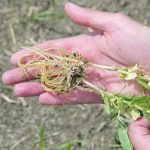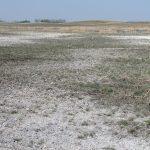
Stories by Margaret Evans


Ancient gene protects plants from caterpillars
Researchers gain a better understanding of how plants recognize peptides that caterpillars produce while feeding
Plants have inherited certain receptors that can recognize pathogens and diseases, which then triggers immune responses. But understanding how plants evolved that ability has been limited. Now scientists at the University of Washington are exploring key evolutionary events that enabled plants to develop responses to common threats. The research focused on the caterpillar. Researchers knew […] Read more
Plant roots use hydro-signalling to sense water
Hormones respond to the presence or absence of water, allowing roots to stop growing when they lose contact with it
Roots are central to plant growth and recent research has shown just how efficient they are and how precisely they forage to find water, minimize water stress and adapt their shape while branching out to secure moisture. Now, researchers at the University of Nottingham in the United Kingdom have discovered how roots pause their branching […] Read more
Researchers discover semi-dwarf wheat gene
Wheat with the Rht13 gene could be bred with other varieties to expand the production of climate resilient crops
Semi-dwarf wheat varieties have been used for decades, but they have limitations. The dwarfing aspect affects all stages of growth including the restricted growth of a seedling and the emergence of the first leaf and stem that will transport the young plant from its embryo stage to the soil surface, a process known as coleoptile. […] Read more
Activity at cellular level helps plants avoid salt damage
A hormone is activated when plants sense local deposits of salt, which triggers a response for roots to avoid the area
Plants do not like salt. To avoid saline areas, they have a vital mechanism that allows them to change their root direction and grow away from it. But how they do that has been unclear until now. Recently, researchers at the University of Copenhagen in Denmark discovered what happens inside plants at the cellular and […] Read more
Increased CO2 exposure can hinder crop growth
Researchers discover that plants exposed to higher carbon dioxide levels in the atmosphere take up less phosphorus
Researchers have discovered that when plants are exposed to increasing levels of carbon dioxide in the atmosphere, the phosphorus levels in their shoots and leaves decrease. Phosphorus is essential for growth but researchers at Michigan State University have discovered that the phosphorus reduction is an adaptive response of plants to increasing carbon dioxide levels worldwide. […] Read more
Methane studied in Japanese breed

Climate change, antibiotics may threaten soil
Researchers say livestock antibiotic residues can degrade microbe activity when combined with rising temperatures
Higher temperatures brought on by climate change in many regions can disrupt soil microbe effectiveness, recent research shows. A study by researchers at the Cary Institute of Ecosystem Studies in Millbrook, New York, has shown that when rising temperatures combine with antibiotic residues expelled by livestock, it degrades soil microbe efficiency, soil resilience to future […] Read more
Research re-examines soil health measurements
Some scientists focus on chemistry, biology and physics, while others look at factors such as the ratio of small to large molecules
Researchers at Cranfield and Nottingham universities in the United Kingdom believe farmers and land managers need to change how they think about, measure and study soil. “I have been working on soils in various contexts for the last four decades from my early work on the restoration and reclamation of open-cast mines (strip mines) to […] Read more
Hormone helps plants better react to stress
Research discovery sheds light on how crops decide when to switch their energy use from growth to threat response
Crops often face harsh growing conditions and, when faced with challenges, instead of using energy for growth they are forced to use the energy to respond to threats such as disease, extreme temperatures and changing soil conditions. This switch in focus is known as the growth-stress response trade-off, but little is known about how it […] Read more


